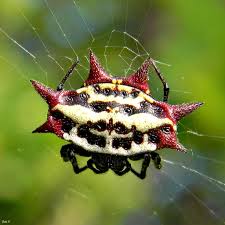Jewelled Spider
Category: Arachnida Spider

Facts about Jewelled Spiders, "Scientific name for Jewelled Spider is Gasteracantha cancriformis". The Jewelled Spider, has a number of other names such as the Jewel spider, star spider, spiny orbweaver spider and smiley faced spider. Its Latin name means belly of thorns. The Australian species is sometimes called Cat-faced Spider.
The species has these names because it has six spines projecting out of its back and a dot pattern reminiscent of a jewel or, in modern terms, a smiley face. The spines may be red or black if the Jewelled Spider’s back is white. The spines are always black if the Jewelled Spider is yellow.
Female Jewelled Spider are 1/5 (.51 cm) to 1/3 (.76 cm) and half an inch (1.27 cm) wide. Their legs are unusually short for spiders.
The Jeweled spider has a very wide range. They are found in the southeastern United States, Central America and Australia. The North American speices is called Araneus gemmoides. Austracantha minax, also called the Jeweled spider, lives only in Australia. However, all Jeweled spider species only live in tropical and sub-tropical areas.
Jewelled Spiders have oversize brains.
In the Jewelled Spider the oxygen is bound to "hemocyanin" a copper-based protein that turns their blood blue, a molecule that contains copper rather than iron. Iron-based hemoglobin in red blood cells turns the blood red
Jewelled Spiders have two body parts, the front part of the body is called the Cephalothorax-(the thorax and fused head of spiders). Also on this part of the body is the Jewelled Spider’s gland that makes the poison and the stomach, fangs, mouth, legs, eyes and brain. Jewelled Spiders also have these tiny little leg-type things called (pedipalps) that are next to the fangs. They are used to hold food while the spider bites it. The next part of the Jewelled Spiders body is the abdomen and the abdomens back end is where there is the spinnerets and where the silk producing glands are located.
Jeweled spiders create circular webs to catch their prey. They are located three to six feet (.91 to 1.82 meters) above the ground, and they usually catch flying insects like flies.
The Jeweled spider tends to live in woodlands, and they are often found in orchards.
The Jeweled spider only lives long enough to reproduce. The females die after laying their eggs. Males die even sooner, a few days after mating, in those cases where he wasn’t eaten by the female.
Most Jeweled spiders typically live solitary lives, though the Christmas spiders (the Australian species Austracantha minax) live in communal webs. In some areas, their webs may overlap. The Jeweled spiders are unusual in that they will share prey that land on their webs.
Jeweled spiders, no matter the species, are not poisonous to humans.
The muscles in a Jewelled Spiders legs pull them inward, but the spider can't extend its legs outward. It will pump a watery liquid into its legs that pushes them out. A Jewelled Spider’s legs and body are covered with lots of hair and these hairs are water-repellent, which trap a thin layer of air around the body so the Jewelled Spiders body doesn't get wet. It allows them to float, this is how some spiders can survive under water for hours. A Jewelled Spider feels its prey with chemo sensitive hairs on its legs and than feels if the prey is edible. The leg hair picks up smells and vibrations from the air. There are at minimum, two small claws that are at the end of the legs. Each Jewelled Spiders leg has six joints, giving the spider 48 leg joints. The Jewelled Spider’s body has oil on it, so the spider doesn't stick to it’s own web.
A Jewelled Spiders stomach can only take liquids, so a spider needs to liquefy their food before they eat. They bite on their prey and empty its stomach liquids into the pray which turns it into a soup for them to drink.
A male Jewelled Spider has two appendages called "pedipalps" a sensory organ, instead of a penis, which is filled with sperm and insert by the male into the female Jewelled Spider’s reproductive opening.
Jewelled Spiders do not have a skeletons. They have a hard outer shell called an exoskeleton-(a rigid external covering for the body in some invertebrate animals). The exoskeleton is hard, so it can’t grow with the spider. The young Jewelled Spiders need to shed their exoskeleton. The Jewelled Spider has to climb out of the old shell through the cephalothorax. Once out, they must spread themselves out before the new exoskeleton will harden. Know they have some room to grow. They stop growing once they fill this shell. Female Jewelled Spiders are usually bigger than males.
Female Jewelled Spiders lay eggs on a bed of silk, which she creates right after mating. Once the female Jewelled Spider lays her eggs, she will than cover them with more silk.
Spiders belong to a group of animals called "arachnids", mites and Scorpions and a tick is also in the arachnid family. An Arachnids is a creature with eight legs, two body parts, no antennae or wings and are not able to chew on food. Spiders are not insects because insects have three main body parts and six legs and most insects have wings.
The Arachnids are even in a larger group of animals called "arthropods" an invertebrate animal of the large phylum Arthropoda, which also include spiders, crustaceans and insects. They are the largest group in the animal world, about 80% of all animals come from this group. There are over a million different species. There are more than 40,000 different types of spiders in the world.

 Back To Category Arachnida Spider
Back To Category Arachnida Spider